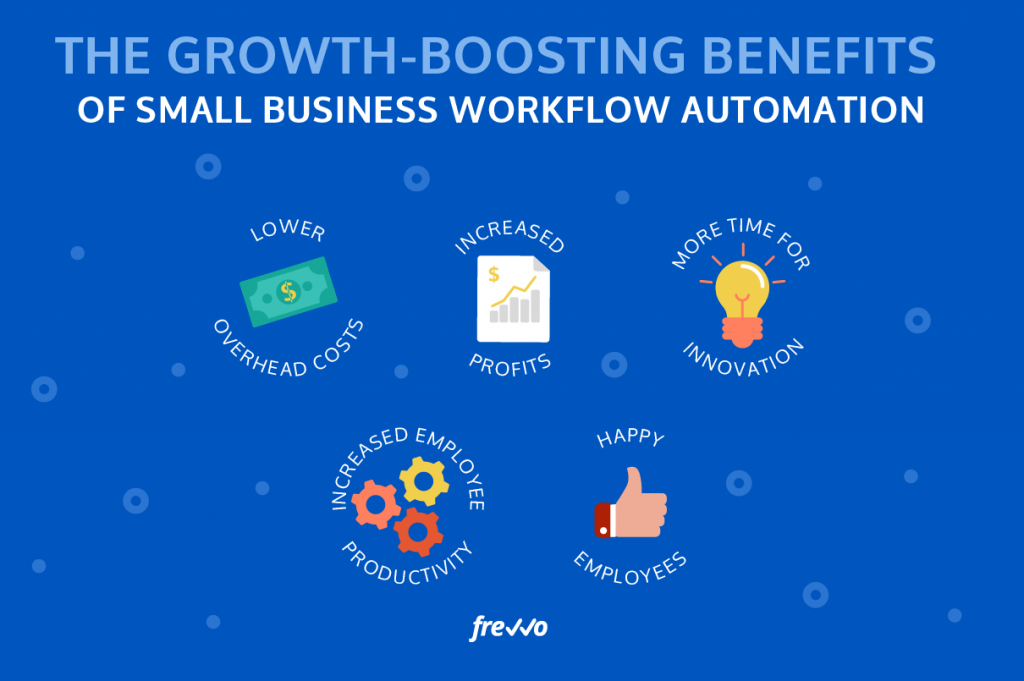Automation for small enterprises streamlines operations and reduces costs. It enhances productivity and allows businesses to focus on growth.
Small enterprises can benefit significantly from automation. By automating repetitive tasks, businesses save time and reduce human errors. This allows staff to focus on more strategic activities, fostering innovation and growth. Automation tools can manage inventory, handle customer inquiries, and streamline financial processes.
These tools are often affordable and easy to implement, making them accessible for small enterprises. Embracing automation can lead to increased efficiency, better customer service, and higher profitability. Small businesses that adopt automation early can gain a competitive edge in their market. Investing in the right automation solutions is crucial for long-term success and sustainability.
Introduction To Automation
Automation can revolutionize the way small enterprises operate. It streamlines tasks and enhances productivity. Automation helps businesses save time and money. It allows owners to focus on growth and innovation.
What Is Automation?
Automation involves using technology to perform tasks without human intervention. This can range from simple tasks like sending emails to complex processes like managing inventory.
- Reduces manual labor
- Increases efficiency
- Minimizes errors
Importance For Small Enterprises
For small enterprises, automation is a game-changer. It levels the playing field with larger companies.
| Advantages | Details |
|---|---|
| Cost Savings | Reduces the need for additional staff. |
| Time Efficiency | Automates repetitive tasks. |
| Improved Accuracy | Minimizes human errors. |
Automation can handle various tasks. This includes invoicing, customer service, and social media management.
- Boosts productivity
- Enhances customer experience
- Fosters business growth

Credit: www.frevvo.com
Benefits Of Automation
Automation has become a game-changer for small enterprises. It streamlines operations, reduces errors, and boosts productivity. Here, we explore the key benefits of automation for small businesses.
Increased Efficiency
Automation significantly enhances efficiency in small enterprises. By automating repetitive tasks, businesses save time. Employees can then focus on more strategic activities. This shift leads to faster completion of tasks and improved workflow.
- Automated systems work round the clock.
- Tasks are completed faster and more reliably.
- Employees can focus on creative and strategic tasks.
Cost Savings
Automation also leads to substantial cost savings. Automated processes reduce the need for manual labor. This cuts down on labor costs. Additionally, automation minimizes errors, saving money on corrections.
| Cost Component | Before Automation | After Automation |
|---|---|---|
| Labor Costs | $10,000/month | $5,000/month |
| Error Correction Costs | $2,000/month | $500/month |
Enhanced Accuracy
Automation significantly boosts accuracy in business operations. Manual data entry often leads to errors. Automated systems reduce these errors considerably. This ensures more reliable and accurate outcomes.
- Data entry becomes more precise.
- Errors are minimized.
- Quality of work improves.
Automating your business processes is a step towards better efficiency, cost savings, and accuracy.
Key Areas To Automate
Automation helps small enterprises save time and reduce errors. Automating key areas can boost productivity and growth. Here are the essential areas to automate:
Customer Relationship Management
Managing customer relationships is crucial. Automate tasks like email campaigns, follow-ups, and customer support. Automation tools can segment customers based on their behaviors. This helps in sending personalized messages. You can also track customer interactions efficiently.
- Email Campaigns: Schedule and personalize emails.
- Follow-Ups: Set automatic reminders for follow-ups.
- Customer Support: Use chatbots for instant responses.
Inventory Management
Automate inventory to avoid stockouts and overstocking. Real-time tracking helps maintain optimal stock levels. Automation tools can generate reorder alerts. You can also track sales trends and forecast demand. This reduces waste and improves cash flow.
| Feature | Benefit |
|---|---|
| Real-Time Tracking | Maintain optimal stock levels |
| Reorder Alerts | Prevent stockouts |
| Sales Trends | Forecast demand |
Accounting And Finance
Automating accounting reduces errors and saves time. Automated invoicing, payroll, and expense tracking are crucial. These tools ensure compliance and financial accuracy. Automate tax calculations to avoid penalties. Generate financial reports with a click.
- Invoicing: Create and send invoices automatically.
- Payroll: Automate employee payments.
- Expense Tracking: Monitor expenses in real-time.
- Tax Calculations: Calculate taxes accurately.
- Financial Reports: Generate reports instantly.
Choosing The Right Tools
Choosing the right automation tools can significantly boost efficiency for small enterprises. The right tools help streamline operations and reduce manual tasks. Understanding the criteria for selecting these tools is crucial.
Criteria For Selection
There are several factors to consider when selecting automation tools:
- Ease of Use: Tools should be easy to learn and implement.
- Cost-Effectiveness: Choose tools that fit your budget.
- Scalability: Ensure the tools can grow with your business.
- Integration: Look for tools that integrate with your existing systems.
- Support and Training: Good customer support and training resources are essential.
Popular Automation Tools
Here are some popular automation tools for small enterprises:
| Tool | Features | Price |
|---|---|---|
| Zapier | Connects apps, automates workflows | Starts at $20/month |
| Trello | Project management, task automation | Free, Premium starts at $9.99/month |
| HubSpot | Marketing automation, CRM | Free, Paid plans available |
| Slack | Team communication, integrates with many apps | Free, Premium starts at $6.67/month |
Each tool has unique features that can benefit small enterprises. Evaluate the tools based on your specific needs and criteria. Make sure to choose tools that will help your business grow and become more efficient.
Implementation Strategies
Automation can transform small enterprises by enhancing efficiency and reducing costs. Implementing automation requires careful planning and execution. Here, we will discuss key strategies to ensure a smooth transition.
Planning And Preparation
Planning is the first step for successful automation. Begin with identifying repetitive tasks that consume time. List these tasks and evaluate which ones can be automated.
Create a roadmap outlining the steps and timeline for implementation. Break down the process into manageable phases to avoid overwhelm.
Budgeting is crucial. Allocate funds for purchasing software and training staff. Ensure you have a clear idea of the costs involved.
Consider using a simple table for planning:
| Task | Automation Tool | Timeline | Budget |
|---|---|---|---|
| Invoicing | QuickBooks | 2 weeks | $500 |
| Email Campaigns | Mailchimp | 1 month | $300 |
Training And Support
Training your team is essential for successful automation. Conduct workshops and provide resources to help employees understand new tools.
Create a support system to address any issues that may arise. Assign a point of contact for troubleshooting and assistance.
Use an ordered list to outline training steps:
- Identify key team members for training.
- Schedule training sessions.
- Provide training materials and resources.
- Conduct hands-on practice sessions.
- Evaluate proficiency and provide feedback.
Continuous support ensures that your team adapts well to automation. Regular check-ins and feedback sessions can help maintain efficiency.
Remember to highlight important training resources in bold for easy reference:
- User manuals
- Online tutorials
- Webinars
- Q&A sessions
Providing adequate training and support ensures a smoother transition and maximizes the benefits of automation.
Overcoming Challenges
Automation offers many benefits to small enterprises. These include increased efficiency and reduced costs. But, the journey to automation is not without its challenges. Understanding and overcoming these challenges is crucial. This section discusses the common obstacles and best practices.
Common Obstacles
Small enterprises often face several obstacles in automation. Some of the most common challenges include:
- High initial costs
- Lack of expertise
- Resistance to change
- Integration issues
| Obstacle | Description |
|---|---|
| High Initial Costs | Investment in automation tools can be expensive. |
| Lack of Expertise | Employees may lack skills to use new systems. |
| Resistance to Change | Staff may be hesitant to adopt new technology. |
| Integration Issues | New tools may not integrate with existing systems. |
Solutions And Best Practices
Overcoming these challenges requires strategic planning and effective solutions. Here are some best practices:
- Plan Budget Wisely: Allocate funds for automation tools and training.
- Invest in Training: Ensure employees receive proper training.
- Communicate Benefits: Highlight how automation improves workflow.
- Choose Compatible Tools: Select tools that integrate with current systems.
Following these practices can smooth the transition to automation. It helps small enterprises maximize their investment and achieve desired outcomes.
Measuring Success
Automation can transform small enterprises. But how do you measure its success? Knowing what metrics to track is essential. This section dives into key performance indicators (KPIs) and the importance of continuous improvement.
Key Performance Indicators
Key Performance Indicators (KPIs) are metrics that help track progress. They offer insight into how well your automation efforts are doing. Here are some crucial KPIs for small enterprises:
- Time Savings: Measure the hours saved through automation.
- Error Reduction: Track the reduction in errors.
- Cost Savings: Calculate the money saved.
- Customer Satisfaction: Assess customer feedback and ratings.
Tracking these KPIs helps you understand the impact of automation. It also helps in making data-driven decisions.
Continuous Improvement
Continuous improvement ensures that your automation processes remain effective. Small enterprises should always look to optimize and refine their systems. Here are some steps for continuous improvement:
- Regular Reviews: Schedule regular reviews of your processes.
- Feedback Loop: Collect feedback from employees and customers.
- Performance Analysis: Analyze the performance data regularly.
- Update Systems: Keep your systems updated with the latest technology.
These steps ensure that automation keeps adding value to your business. They help in maintaining efficiency and productivity.
Remember, measuring success is an ongoing process. Use these strategies to maximize the benefits of automation in your small enterprise.

Credit: www.desuvit.com
Future Trends In Automation
Automation is revolutionizing small enterprises. It’s making them more efficient and competitive. Let’s explore future trends in automation that small enterprises should watch.
Ai And Machine Learning
Artificial Intelligence (AI) and Machine Learning (ML) are game changers. They help businesses predict trends and automate tasks. AI can handle customer service through chatbots. This reduces workload and improves response time.
ML analyzes data to find patterns. These patterns help in making better decisions. For example, ML can predict inventory needs based on past sales. This helps in managing stock efficiently.
Integration With Iot
The Internet of Things (IoT) connects devices for smarter operations. Small enterprises can benefit greatly from this. IoT can automate routine tasks and improve efficiency.
Consider a small retail store. IoT devices can monitor stock levels in real-time. This ensures timely restocking and reduces wastage. Another example is smart thermostats. They can save energy by adjusting temperatures automatically.
| Future Trends | Benefits |
|---|---|
| AI and ML | Predict trends, automate tasks, improve decision-making |
| Integration with IoT | Real-time monitoring, energy saving, improved efficiency |
Embracing these trends can give small enterprises a competitive edge. They can operate more efficiently and serve customers better.

Credit: www.kuka.com
Frequently Asked Questions
How Do I Automate My Small Business?
Automate your small business by using tools for accounting, customer relationship management, inventory, and marketing. Implement workflow automation software. Integrate communication platforms for team collaboration. Utilize AI for customer service and data analysis. Regularly update and maintain your systems for efficiency.
Is Automation Necessary For Small Businesses?
Automation is essential for small businesses. It boosts efficiency, reduces errors, and saves time. Small businesses can compete better and grow faster with automation.
What Is Business Process Automation For Sme?
Business process automation for SMEs involves using technology to streamline and automate routine tasks. It increases efficiency, reduces errors, and saves time.
How Many Small Businesses Use Automation?
Approximately 31% of small businesses use automation. Automation helps streamline operations and improve efficiency. Many businesses adopt automation tools to stay competitive and save time.
Conclusion
Embracing automation can significantly boost efficiency for small enterprises. It saves time, reduces errors, and streamlines operations. By investing in the right tools, small businesses can compete with larger companies. Start automating today to enhance productivity and drive growth. The future of your business could depend on it.








